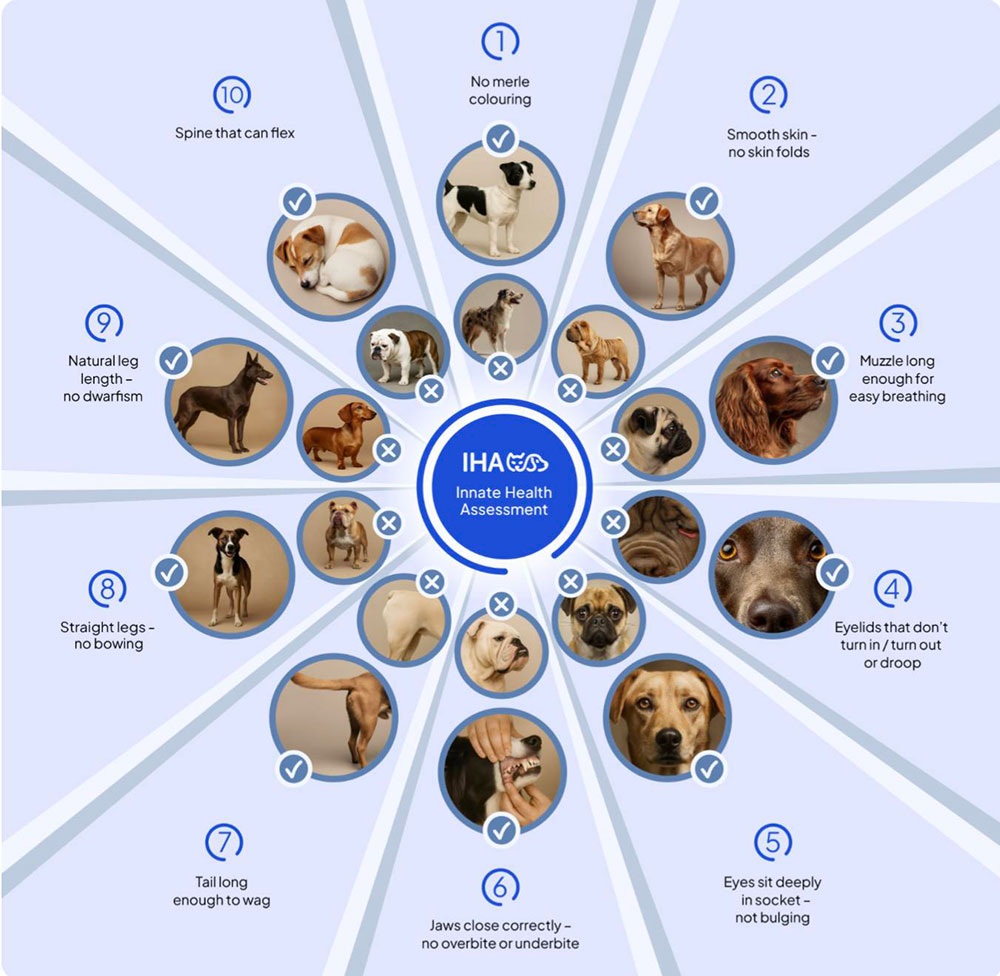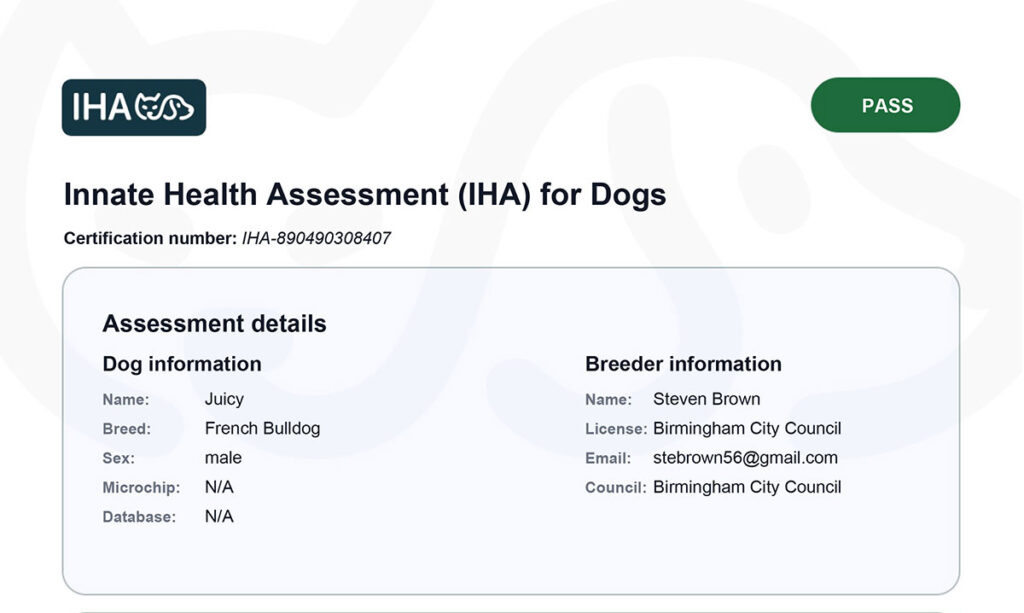Last year , I sat in a committee room in Parliament listening to Dan O’Neill of the Royal Vetinary Collage, explain how simple it is to recognise extreme conformation.
The way he described it was clear and easy to understand and my first thought was… why doesn’t everyone who buys a puppy already know this?
Most of the websites and marketplaces that advetise puppies for sale don’t mention it.
To find good information, you have to dig through specialist websites or academic papers, and most buyers never do that.
This gap in understanding is one of the reasons why extreme traits continue to appear in dogs, even though many experienced breeders avoid them.
With that in mind, it’s important to say upfront that this article is an independent opinion, written to support licensed breeders and those working towards their licence within the MLB network.
Our goal is simple and it’s to help breeders understand what the tool is, how it is being used, and where it sits alongside existing law and licensing guidance across all nations of the UK.
Like our members, we support high welfare standards. We also believe breeders deserve clear information, fair expectations, and practical guidance.
A simple indication tool.
The genius about this is the simplicity.
The Innate Health Assessment tool is a 10-point visual checklist designed to highlight features linked to extreme conformation.

It focuses on traits such as:
- very short muzzles
- excessively folded skin
- bulging eyes
- short or kinked tails
- bowed limbs
- restricted spinal movement
- merle and dapple colouring
- extreme jaw shape
The idea is that anyone – including breeders, buyers, vets, or inspectors can give a dog a simple pass or fail score on each feature. The tool then produces an overall risk picture.
The simplicity is seen as a positive step towards raising awareness by many in the welfare sector and by rescues who deal with dogs suffering from conformation-related health issues.
However, it’s worth noting that the tool does not replace:
- veterinary assessments
- clinical examinations
- breed-specific health testing
- established breeding schemes
- the legal standards set out in the licensing regulations
It is also important to remember that the tool is currently voluntary, and there is no legal requirement for breeders to use it.
How will this tool affect inpections?
Before looking at how inspectors may use the IHA, breeders must understand what the regulations already require. The duty to consider conformation is not new, it has been part of UK animal welfare and licensing law for years.
England — Animal Welfare (Licensing of Activities Involving Animals) Regulations 2018
For licensed breeders, the key clause is:
Schedule 6, paragraph 6(5):
“No dog may be kept for breeding if it can reasonably be expected, on the basis of its genotype, phenotype or state of health, that breeding from it could have a detrimental effect on its health or welfare or the welfare of its offspring.”
In plain terms:
Breeders must not breed from a dog if its physical shape or inherited traits are likely to cause problems.
The statutory guidance for local authorities also reminds inspectors to consider conformation as part of the welfare assessment during inspections.
Wales — Breeding of Dogs Regulations 2014
These regulations also require that:
- breeding dogs must be physically sound
- welfare must not be compromised by inherited or physical traits
- premises must meet detailed care and environmental standards
Wales is also looking at conformation closely as part of its recent licensing review and we hope it doesn’t add another layer of confusion.
Scotland — Licensing of Activities Involving Animals (Scotland) Regulations
Scotland takes a similar approach, with licensed breeders required to ensure:
- dogs bred from are healthy
- breeding does not cause suffering
- inherited conditions are managed responsibly
Last year Scotland passed the Welfare of Dogs (Scotland) Bill and its intention to tackle breeding and supply issues, including mention of undesirable breeding practices.
Northern Ireland
Northern Ireland runs its own breeding establishment licensing system. Although structured differently, inspectors still assess whether breeding practices risk causing suffering, including issues linked to body shape.
However, DAERA Minister Andrew Muir announced the establishment of an expert advisory group to review Dog Breeding Regulations in Northern Ireland.
Is this tool a mechanism to ban certain breeds?
Some breeders would be rightly concerned that the Innate Health Assessment (IHA) is intended to phase out certain breeds, especially French Bulldogs, Pugs, and other brachycephalic types.
Some welfare supporters have described the tool as the beginning of a “breeding revolution”, and the public message around extreme conformation can easily give the impression that certain breeds will no longer be acceptable under licensing.
To test how the tool actually behaves, we carried out an assessment using a French Bulldog with moderate features.
The result suggesed the dog passed the assessment, scoring 8 out of 10 criteria, which the system classified as an 80% pass
Where confusion can arise
There is a gap between the public narrative and the tool’s actual behaviour.
The general narrative around the tool imply that breeding short-nosed, merle or dapple dogs should stop altogether, and supporters have described it as the start of a “revolution” aimed at removing extreme traits.
The press and social media posts promoting the project are using emotional headlines rather than actually explaining how it fits within existing regulation.
The licensing regulations require inspectors to assess individual dogs, not whole breeds, these are areas where confusion can occur, especially for brachycephalic breeds like French Bulldogs.
All French Bulldogs are brachycephalic by definition but not all French Bulldogs have extreme conformation, and that distinction is important.
Support and Mixed Messaging
The IHA has attracted strong support from many well-known welfare organisations, which is one reason the public conversation around it has become so charged.
These groups see the tool as a simple way to highlight extreme conformation and improve awareness as do we.
However, the Kennel Club’s position is more cautious. Although their logo appears alongside the project, the KC has clarified that they did not set the criteria, were not involved in the tool’s development, and have concerns about how it may be used.
They are creating their own breeding-for-health framework, which takes a different approach.
This mix of strong welfare support and a more measured stance from the KC adds to the confusion breeders are experiencing about how the tool should be interpreted.
Our Conclusion
The Innate Health Assessment is an interesting tool, and the basic idea behind it is useful.
A simple visual guide to extreme conformation could make a real difference if it reached the right audience, especially puppy buyers and unlicensed breeders who often enter the market with little understanding of the welfare risks linked to certain physical traits.
However, it does seem that the focus almost entirely on licensed breeders, and it sits behind a data-collection wall that asks for personal and licensing information. With the commissioning of the Frontier Economics report, it is reasonable to assume that the data gathered through the tool will be used to support future policy discussions.
Our concern is not with the aim of improving welfare, but with the quality of the data being collected.
Based on our own testing, users can submit unverified details, create assessments for any dog, and produce formal-looking certificates without checks.
Without verification, the resulting dataset will be skewed and unrepresentative, and any policy shaped from it risks being built on weak foundations.
Licensed breeders deserve clarity, accuracy and fairness in the tools and frameworks that may influence their future. The IHA may play a role in education, but its current design makes it better suited to informing buyers than forming the basis of regulatory decisions.
This may change and we will continue to support our members by monitoring how councils use this tool and keeping you updated on any developments that may affect your licensing conditions.
Resources:
https://www.frontier-economics.com/uk/en/news-and-insights/news/news-article-i21993-health-over-hype-the-case-for-breeding-reform-in-england/
https://www.facebook.com/groups/374442803021569/posts/2374021969730299/
https://www.innatehealthassessment.org/







